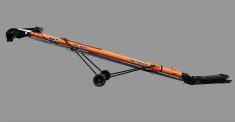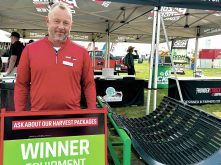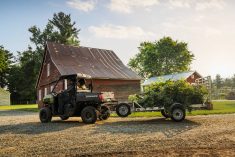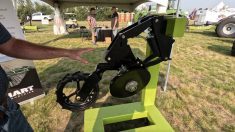There has been no shortage of innovative machines introduced in agriculture over the past few years — and we certainly expect more to come. Arguably, one of the most unique of those designs has to be Vermeer’s ZR5-1200 self-propelled round baler. The company had one on display at the Ag in Motion farm show in Langham, Sask., in July. Grainews spoke to Corey Dalman, territory manager for Vermeer’s forage equipment line, on the show grounds to get the lowdown on what it has to offer producers.
[VIDEO] AgDealerTV: Vermeer’s ZR5-1200 baler
Around 2018, an engineer at Vermeer came up with the idea for a zero-turn baler while cutting the grass on his own zero-turn lawn mower. A short time later, the first prototype zero-turn baler was in field trials. The ZR5-1200 baler has now been in full production for approximately four years.
Read Also

Claas brings 1000 Series SP forage harvesters to Canada
In mid-August, Claas unveiled its new line of Jaguar forage harvesters at an event in Visalia, California, deep in the heart of that state’s dairy region.

At the back, the actual baler is based on Vermeer’s existing 605 design.
“This is the same as our 605M baler, which we’ve had available in various configurations for close to 13, 14 years now,” he said. “It’s basically the same concept with some updates.”
The biggest advantage offered by the zero-turn, self-propelled concept is improved productivity in the field.
“In one of the tests I did in the Interlake in Manitoba a few years ago, we were in the same field where a customer had a 605M baler on a Fendt tractor with a CVT transmission. This (ZR5-1200) is hydrostatic, so that in my opinion is very apples to apples. He’s not shifting through gears. The big difference in the productivity with this machine was at the headlands. He would have to go out and make a big swing, whereas I could turn around and go right back down the next windrow. By the time he turned and got into his windrow, I was half-way down the field already. And that’s where the big productivity change is with this, it’s the manoeuvrability. With a tractor, it doesn’t matter how fast you bale, you still need to make a wide turn at the end.”

Field mode and road mode
The baler has two operating modes — field mode, which uses the zero-turn steering system, and road mode, which reverts to a conventional steering system.
“In field mode, it will travel and bale up to 12 m.p.h. (19 km/h),” Dalman says. “It’s completely, 100 per cent, zero turn with a steering wheel. For road transport from field to field, we have what we call road mode. The (front) wheels caster in the field, like a lawn mower. But in road mode they lock up and steer like a tie rod system. That will give us road speeds up to 35 m.p.h. (60 km/h).”

Because of the large rear wheels and overall machine configuration, the baler doesn’t bounce as badly at high field speeds like a conventional pull type does. And the large radial rear wheels also offer some suspension to smoothe out the ride for the entire machine, including the operator.
“The pickup on this machine is exactly between the back wheels,” Dalman adds. “The pickup moves up and down with the baler, whereas on a pull type the pickup is independent and moves independently of the baler. The capacity of this baler is 100 per cent equal all the time because the throat isn’t closing up and expanding all the time. You’ll actually see a little more productivity out of this, even though it is the same baler (as the 605 pull type).”
To handle heavy windrow conditions, the pickup is eight feet wide. And even though it’s beneath the machine, an underbody camera allows the operator to see it on the in-cab monitor. And the upfront cab makes it easier to see any rocks or obstructions before they get to the pickup.

Automated functions
Power comes from a 200-horsepower, four-cylinder Cummins diesel. And it uses a hydrostatic driveline. A single multi-purpose joystick controls ground speed and several other automated functions that take over most of the tasks an operator has to manually perform on a pull-type baler.
“This baler, compared with our pull types, is all automated,” says Dalman. “On a pull type, the customer still has to run the hydraulics on the tractor to eject the bale and close the door. With the joystick in the cab, you set your ground speed. You leave the joystick there. When it gets to the point the bale is ready to start wrapping, the machine will actually slow down and stop on its own. It’ll wrap the bale on its own and close the door. Then it will just sit there and wait for you to give it the command to go again, which is the resume button on the joystick. Just like cruise control on a vehicle.”
And the baler was designed for efficient maintenance and easy updating as well, including allowing for complete removal and replacement of the baler body in just a few minutes.
“The thing most people don’t realize is the baler portion of this baler is actually removable in less than five minutes for servicing or repairs, or if you wear it out. There’s a rocker switch in the cab you push. It will actually pick the baler up and set it on the ground hydraulically.
“We sell the baler portion independently. Guys that do a lot of bales will buy another baler (body), so they have a spare machine if they have a major breakdown.”
















